This year, the series highlights established figures such as Heinz Emigholz, Robinson Devor, Jem Cohen as well as newcomers Theo Anthony (Rat Film), Salomé Jashi (Dazzling Light of Sunset) and Shengze Zhu (Another Year).
It also gives well deserved recognition to the Chilean cinema with two from documentary veteran Ignacio Agüero and two from José Luis Torres Leiva whose film The Sky, the Earth and the Rain made an international splash in 2008. His new film The Wind Knows I'm Coming Back Home, starring Agüero will be shown as well.
This edition also pays tribute to radical Brazilian filmmaker, Andrea Tonacci who founded Cinema Marginale against more conventional Cinema Novo movement. It will be a rare accasion to see his films - Blah, Blah, Blah, Bang Bang and Hills of Disorder, all in 35mm.
As I cover the series in its forth year, I realize that this so-called nonfiction/hybrid way of filmmaking has always been present as long as the film medium has been around, intrinsically woven into its DNA, yang to the narrative fiction filmmaking's yin, that it's not a groundbreaking, brand new thing to be embraced. But for me, it's a much more exciting, stimulating and less limiting form than the narrative fiction ever will be. Art of the Real remains to be the coolest film series even for New York Standards. Below are some of the highlights from the series:
Rat Film - Theo Anthony *Opening Night Film
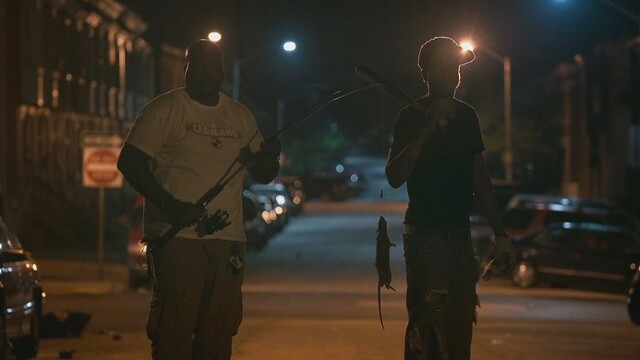
There hasn't been a film that more effectively and entertainingly illustrates the 'inner city' problems than Theo Anthony's Rat Film. The subject is Baltimore, MD. Just like many declining city on the Eastern Seaboard, Baltimore has its share of problems with violence, segregation and poverty ever since the urban planning became a thing after the great depression. Anthony connects the dots with the city's rat problem and poor living conditions of its inhabitants, juxtaposing and paralleling at length, the science experiments involving rats since the 30s (by the Johns Hopkins researchers), and that of human counterparts.
Rat Film is perhaps the most devastating, thought-provoking anthropological study ever put on film in years. It slyly brings forth the institutionalized racism using not only wealth of data, an old educational film sounding narration, VR graphics but also human characters and their interactions. He shows inadequacies and impersonable nature of the data and technology in illustrating the human cost of an American inner city's decline and gracefully balances out with the presence of a philosophical city pest control officer who guides us through the vagaries of human life. Definitely one of the year's very best.
This is the Way I Like it II - Ignacio Agüero

A fascinating survey of Chilean cinema through historical as well as personal context, Ignacio Agüero makes This is the Way I Like It II/Como me da la gana II a delightful viewing. As one of Latin America's leading documentarians, Agüero started making films under Pinochet and persisted to film on the street while his political filmmaker friends went into exile. He was one of the filmmakers who directed political commercials and featured in Pablo Larrain's No. In his 1985 short film This is the Way I Like it, which is integrated in the newer version, among with his other films, he is seen asking his filmmaker friends why they are out on the streets filming violent clashes between protesters and police.
In the newer version, he 'interrupts' various film sets that are in production in Chile, including Larrain's Neruda, José Luis Torres Leiva's The Wind Knows I'm Coming Back Home and other notable Chilean filmmakers who are making strides on the international cinema scene, and asks them what the essence of cinema is. As they deal with various subjects that are not only limited to politics and history anymore, they give Agüero a vastly different answers to his question.
He also connects dots with his first feature film 100 Children Waiting for a Train, about a children's film workshop that has been continuing for years in Santiago and images of the children watching the screen in silence with his set visits to these new, relatively young filmmakers.
Agüero's images are often gorgeous and his juxtapositions gain more resonance and poignancy as I learn his work. This is the Way I Like It II is not only a self-reflexive work but a great display of enduring power of cinema.
World without End - Jem Cohen
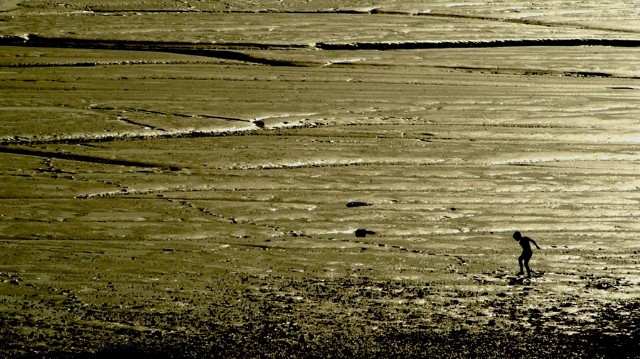
Commissioned by a local arts group in Thames Estuary, a seaside resort area south of London, known as Southend (on-Sea) which encompasses Essex, the Canvey Island facing off Kent to the south, Gem Cohen lovingly documents the foggy streets and a mile and a half stretches of mudflats in low tide. He documents sleepy town full of little shops and its working class inhabitants.
He interviews random people, from a hat store owner with encyclopedic knowledge on English hats, a curry takeout joint restauranteur who witnessed the 2008 economic meltdown to middle-aged music promoters who reminisces about how Southend once was a hot bed for proto-punk. As usual, it's a muted, intimate, observational docu Cohen is known for.
Ama-San - Claudia Varejão
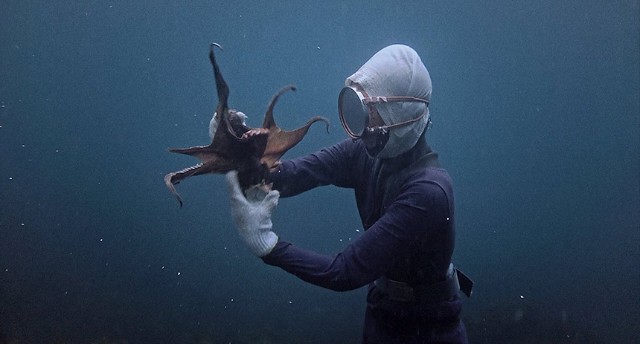
Traditional Japanese women deep sea divers are called Ama-san. They don't rely on oxygen tanks or fancy scuba gears to dive into a cold Pacific ocean to harvest abalone, sea urchins and sea snails. They can just hold their breath for an unnaturally long time. This has been a 2000 year tradition.
Portuguese director Claudia Varejão serenely observes the lives of these modern day mermaids, as they go on their lives. With shallow depth of field, we concentrate on three of these divers and their family lives. Two are grandmothers and one is a mother of three, taking care of domestic duties while diving for the source of income.
I'm a sucker for underwater footage and Ama-San provides some great underwater stuff. After their hard work, they commiserate around irori (Japanese sunken hearth) in a communal space. They eat, doze off, talk about their daily lives.
Varejão takes a more personable, subjective documentary track rather than informational one as the film doesn't go on the details of its geography nor fishing method nor its historical significance. These are not heroic women, trailblazing their field or whatev, or are they portrayed as some sensual objects diving gracefully in and out of ocean. Varejão's interest is elsewhere, in their earthly existence above water, built upon their unusual but deeply traditional jobs underwater.
Dazzling Light of Sunset - Salomé Jashi
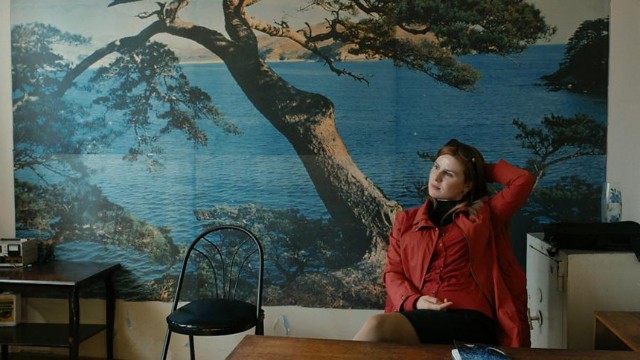
Georgia, known for his unique culture and natural beauty, exemplified by Sergey Parajanov films, is the setting for Dazzling Light of Sunset. The small, two person local TV station at its center, Salomé Jashi's film takes a mirror on the media and its representation of the region.
Dariko, the anchor woman of the station, runs to one story after another, however big or small, filming and interviewing locals and broadcast them for its local viewers. Jashi in turn, goes on and film, not only Dariko and her activities, but weddings, beauty pageant, traditional dances and music on stage, church activities, etc. Dariko and Kakha think they are doing a great job covering and they probably are honest and well intentioned at what they do. They get scolded for covering politicians and local elections (which Dariko hates to cover), because they are seen as colluding with its corrupted officials.
In our media saturated world where everything gets bogged in partisan politics and truth becomes muddled and buried, Dazzling Light of Sunset is an interesting look on how the media sees the world through the glass darkly. It raises the questions about the representation of truth being obscured, even in Jashi's own document.
Casa Roshell - Camilla José Donoso
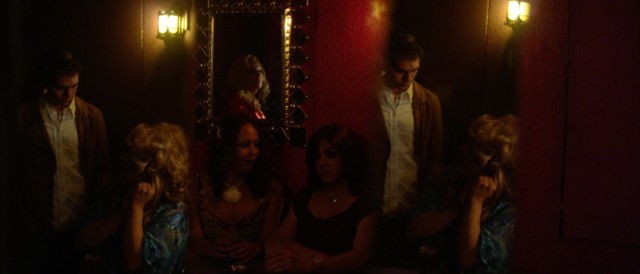
"It's a form of therapy", one of the transgirls explains why the flock to Casa Roshell, the home away from home for men who want to dress up and put on a make up and walk on stilettos. Whether you are trans, bi, gay, looking for fun, romance, sex or just want to be at some place you can be yourself, Casa Roshell is the place. The film starts with the drab reception area seen through the security camera and unglamorous dressing room of the performers. We only see them transforming from men to women through mirrors, as they converse while putting on lingerie, wigs and makeup. Mme. Roshell conducts a workshop on how they learn to walk, dress and behave like a woman.
Colorful lights light up the stage and glamorous Rosh walks up the crowd - "When I started this place, I had nothing. There were police raids and persecution. But what's changed now? Well now we can sue for discrimination. But who has time for that?" People start flirting and negotiate the terms of their romance and decide whether they want to go to the 'dark room' behind the curtain. Married men confess their affection to transgirls because they are very 'feminine'.
The highly stylized, staged courtships have an air of movie romance. Switching to grainy film footage from time to time suggests mingling past and present. Camila José Donoso's film situates itself comfortably between fantasy and reality.
Hills of Disorder - Andrea Tonacci *Tribute to Tonacci Sidebar
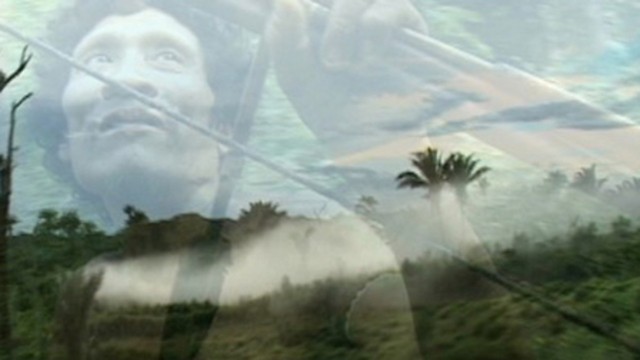
Blending reenactment, archival and real time footage, Hills of Disorder tells a true life story of a Avá-Canoeiro indian deep in the Brazilian Amazon jungle. And it's quite a story- after surviving a massacre of his family, he was captured by townsfolk from a small settlement and lived among them. Then he was relocated to an area where he and his remaining tribe members were reunited.
In the beginning, we follow Carapiru and his large extended family leading their nomadic life in the thick jungle, moving to find a better place to settle, carrying all their belongings - bows and arrows and other stone age tools, a firebrand, a pet monkey on their back and a couple of domesticated boars following their trail. They find a space near water, and sets up camp with thickets and tree branch. This existence must have been the same for thousand of years, until civilization inched toward them and made contact. Then, with a series of archival footage - deforestation, mining, human settlement (to sky scrapers), military coup and violent social upheavals, Tonacci shows a brief history of how things quickly evolved.
Filming Carapiru always in the center of everything, Tonacci makes sure that we get to know him pretty well. Even with Carapiru's limited ability to communicate, his docile demeanor makes him allies wherever he goes.
After returning to Angical, a small settlement North of Goias State in the middle of Brazil where he was first captured, he is welcomed by townsfolk and treated as one of its members. We spend quite some time with Carapiru in Angical until he is suddenly removed again, by a bearded white scientist, who relocates him, first by car, then by plane, to a restricted settlement where remainder of his tribes are. On the way there, he is reunited with his only surviving son who is brought in as an interpreter, who is seen being captured in the massacre in the beginning. Now grown up and educated under civilized world, his son recognizes Carapiru's face.
There are many funny and poignant moments in Hills of Disorder. But unlike other films on the same subject- God Must be Crazy, Walkabout etc., which are fictions, using real life story of a real person re-enacted by himself, the film has a stronger impact without diminishing or exploiting its subject. Truly one of a kind film.
Art of the Real runs April 20 through May 2. Please visit FSLC's website for tickets and more info.